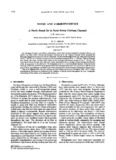| dc.contributor.author | Kinuthia, J H | |
| dc.contributor.author | Asnani, G C | |
| dc.date.accessioned | 2014-07-10T13:02:03Z | |
| dc.date.available | 2014-07-10T13:02:03Z | |
| dc.date.issued | 1982-11 | |
| dc.identifier.citation | Kinuthia, J. H., & Asnani, G. C. (1982). A newly found jet in North Kenya (Turkana Channel). Monthly Weather Review, 110(11), 1722-1728. | en_US |
| dc.identifier.uri | http://journals.ametsoc.org/doi/abs/10.1175/1520-0493%281982%29110%3C1722:ANFJIN%3E2.0.CO%3B2 | |
| dc.identifier.uri | http://hdl.handle.net/11295/72529 | |
| dc.description.abstract | On the basis of recent pilot balloon observations which have become available in northern Kenya, it is shown that there exists a strong southeasterly low-level jet in the Turkana Channel which separates the Ethiopian Highlands the East African Highlands. The jet exists throughout the year, with speeds exceeding 30 m s−1 (60 kt) on a number of occasions and sometimes exceeding 50 m s−1 (100 kt). During February and March, the mean monthly winds based on the morning observations exceed 25 m s−1 (50 kt). The morning winds are stronger than afternoon winds, presumably due to stronger vertical mixing and dilution of the jet maximum in the afternoon. The hodograph turns in a counterclockwise direction from the lowest levels up to 0.75 km (2500 ft) above ground level and sometimes even aloft. Up to 0.45 km (1500 ft) above ground level, the hodograph manifests some of the characteristics of the Southern Hemisphere Ekman layer.
This jet is different from the now well-known East African low-level jet (Findlater 1966, 1977). Earlier climatological charts give no indication of the existence of this jet stream throughout the year. Orographic channeling of flow seems to be responsible for this jet. | en_US |
| dc.language.iso | en | en_US |
| dc.publisher | University of Nairobi | en_US |
| dc.title | A newly found jet in North Kenya (Turkana Channel) | en_US |
| dc.type | Article | en_US |
| dc.type.material | en | en_US |

